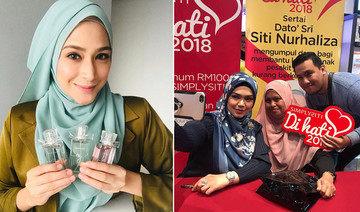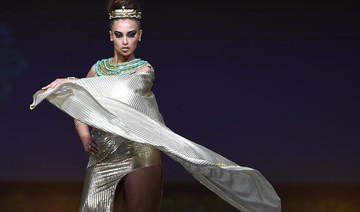SEOUL, South Korea: As she pursued her dream of becoming a fashion model, veering for years between extreme dieting and overeating, Park I Seul realized she had a problem: She was not tall and skinny, like typical runway models, nor was she big enough to be a plus-size model.
She also realized that the only way to meet South Korea’s lofty beauty standards was for her to continuously deny who she truly is.
So Park, 25, began calling herself a “natural size model” — a nearly unheard of term in South Korea — which she defines as someone with the same kind of body you see in daily life, as opposed to a difficult-to-attain ideal. She began to get work, and she started a popular YouTube channel where she introduces fashions for women who look more like her than like the women in fashion magazines.
Her newfound positive view of her body makes her part of a growing movement by South Korean women to resist what they see as extreme pressure to look a certain way.
Hundreds of young women have taken to social media with the hashtag “talcorset,” or take off the corset, to encourage others to free themselves from social stereotypes about their appearance that they feel have long bound them.
Park recently held what she called a “nondiscriminatory” fashion show in Seoul, where models varied in height and weight confidently strode across the stage. Other women have posted online photos or video clips showing themselves cutting their hair short, destroying their beauty products and going to school or work without makeup.
In South Korea, a woman weighing over 50 kilograms (110 pounds) is considered by many to be chubby, regardless of how tall she is.
Park herself is 165 centimeters (5 feet 5 inches) tall and weighs 62 kilograms (137 pounds), which she says puts her far from the minimum 170 centimeters (5 feet 7 inches) and 40 to 48 kilograms (88 to 106 pounds) weight that conventional fashion models have; she’s also nowhere near the XL and above sizes demanded for plus-size models.
“I used to think that my fat body wasn’t the real me and that living in such a body wasn’t my real life. I kept denying myself. I believed that my life would only become happy after I lost weight,” Park said. “I’ve come to think that I look good enough just the way I am.”
South Korea is a deeply conservative country, and experts say its patriarchal society encourages rampant sexism. It had the largest gender pay gap among developed countries in 2017, according to the Organization for Economic Co-operation and Development, and ranks 115th out of 149 nations in the World Economic Forum’s global index of overall gender parity in 2018, among the lowest-ranking G-20 countries.
According to a 2018 survey by Saramin, a leading South Korean recruitment website, 57 percent of human resources managers at South Korean companies agreed that job applicants’ appearances influenced their evaluations. The survey also showed that female applicants are more affected by their looks on their job evaluations than male applicants.
As more women begin to embrace feminism, there’s also a new willingness to challenge strict South Korean societal demands that force women to take extreme care of their looks, according to Sohn Hee-jeong, a researcher at the Institute of Gender Studies at Yonsei University in Seoul.
Consider, for instance, a video by Cha Ji Won, a 24-year-old YouTuber who runs a channel called “Korean Womyn.” The video, which has gotten more than 720,000 views, shows her daily routine after she stopped obsessing over her hair and wearing makeup every day and began choosing and wearing comfortable clothes. It now takes her half the time to prepare to go outside as in the past, and she says she eats whatever she wants and doesn’t think about calories.
“I hoped that by letting other women know that there is someone like me, I could remind them that they don’t have to care too much (about how they look) and spend so much money and time on their appearance,” Cha said in an interview.
The movement can also be found in schools.
An 18-year-old high school senior who wished to be identified only by her last name, Hong, because of worries about her future studies recently exposed a series of lectures at her all girls’ school that promoted a focus on women’s appearance as they entered college. The lecture titles included, “Makeup for college freshmen,” “Fashion styling for college freshmen” and “How to make a healthy body figure.”
Hong objected to her high school recommending classes that appeared to encourage female students to “take care” of their appearance. Hong and some other students contacted journalists to complain about the lectures, prompting the school to remove the classes.
Hong said she put on makeup for the first time when she was in elementary school and was wearing full makeup by high school. She no longer wears makeup and questions why women must always be judged on how they look. However, many children are ashamed of what in Korean is called ssaeng-eol, or bare face, Hong says, and won’t go outside without makeup.
South Korea has the world’s highest ratio of plastic surgeons per capita, according to a report by the International Society of Plastic Surgery in 2016. According to 2015 statistics by Gallup Korea, about one third of South Korean women between 19 and 29 said they’ve had plastic surgery.
“I think (South Korean women) want to look perfect,” said Park Jiehyun, feature?s director at Cosmopolitan Korea, a popular fashion magazine. “They believe they should have a nice body and skin, beautiful eyes, nose and mouth, and even sleek hair with a perfect hairline. They also want to have good style.”
But Park says rising feminist movements and changing values among South Korean women are redirecting her industry’s depiction of beauty.
In its December issue, Cosmopolitan Korea featured a popular South Korean comedian, Lee Young-ja, as the cover model. Lee is larger than the typical skinny cover models the magazine uses.
Still, there’s often intense beauty pressure at work.
Choi Min Jeong, a former employee at a beverage company, still remembers her boss telling her that she had to work harder because she wasn’t as beautiful as a popular South Korean actress.
“Although he said it as a joke, I thought it was ridiculous that he said it when ... my job was unrelated to appearance,” Choi said.
Airline companies often demand a stricter dress code for female flight attendants, according to Kwon Su Jeong, a Seoul councilwoman who has worked for Asiana, a major South Korean airline, for 24 years. Kwon is currently on a leave of absence to work in the city council.
“They control everything, from your hairstyle to the color of your lipstick and nails to the length and shape of your earrings,” Kwon said.
Although Asiana eased a “skirts-only” rule in 2013, many flight attendants still wear them because of worries of negative performance appraisals, Kwon said. Asiana strongly denied that it makes unfair demands or puts pressure on its employees regarding attire or appearance.
Kwon said the company’s upper management wants its flight attendants to uphold an image of a graceful, beautiful Asian woman who provides sincere service to customers. Because the company cares a lot about the appearance of its female employees it puts subtle pressure on them to have cosmetic procedures, she said.
“Although the company is rigid about taking a day off because of injury at work, it is more lenient about taking time off for cosmetic procedures,” Kwon said.
South Korean women begin to resist intense beauty pressure
South Korean women begin to resist intense beauty pressure
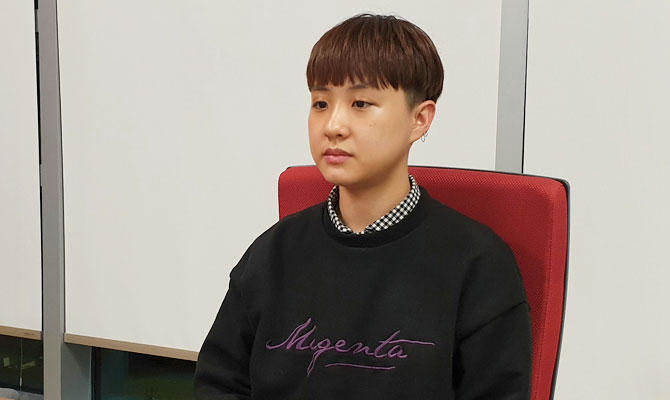
- In South Korea, a woman weighing over 50 kilograms (110 pounds) is considered by many to be chubby, regardless of how tall she is
Simi and Haze Khadra discuss the functional vision of their beauty brand and its Middle East launch
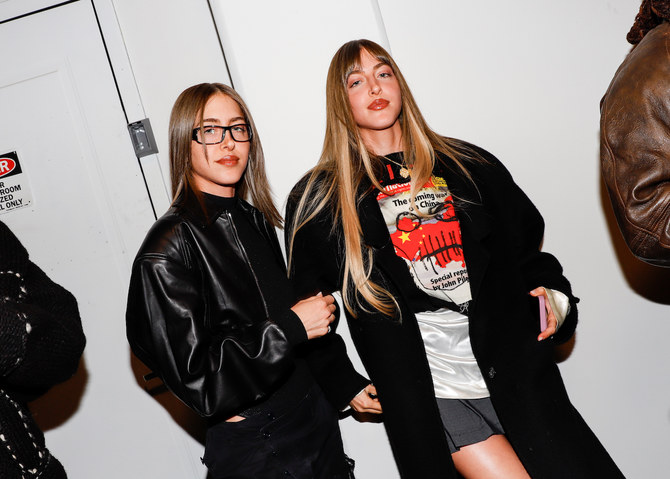
DUBAI: US-Palestinian beauty entrepreneurs Simi and Haze Khadra this week went on tour in the Middle East to launch their brand, SimiHaze Beauty, in the region. Their travels included stops in Saudi Arabia and the UAE.
While in the region, the sister duo — raised by Palestinian parents between Riyadh, London and Dubai — shared insights about their brand with Arab News.
The 31-year-old identical twins, who are also DJs, said that they initially launched the brand out of “pure functionality,” creating products they wanted and needed in their own makeup routines.
Every product they develop undergoes the same rigorous process of ensuring functionality, they said.
“We are constantly thinking of new ideas and ways to make makeup easy and fun to apply,” Simi told Arab News.
The pair launched their US-born cosmetics brand in 2021 with a range of stick-on makeup designs that can be placed on the face for a bold beauty look achievable within seconds.
The sticker book features an array of edgy designs inspired by their favorite DJ looks from the past, such as chrome wings, neon negative space eyeliner and holographic cat-eyes.
SimiHaze Beauty then expanded to include a range of products, such as lipsticks, bronzing powders, and a lifting mascara.
Simi and Haze believe they were “actually late bloomers to the beauty world.”
“We only started becoming interested in it when we were around 18,” Haze said. “We started SHB from just a single product we wanted but couldn’t find in the market, which is our Velvet Blur lipstick.
“We loved a matte lip for every day at the time but couldn’t find one that wasn’t drying, so we created it.”
The twins developed an interest in eye makeup when they began DJ-ing.
“We weren’t the best at applying eyeliner, so again we just created our perfect solution which became the eye stickers,” Haze said.
To the sisters, launching the brand in the Middle East “felt so surreal.”
“The market has been such a huge goal of ours since we started because we grew up here,” Simi said. “We’re so happy that our products are finally accessible to our amazing followers here, because they have been such huge supporters since the beginning.
“Now people are finally able to really see and touch and feel the products, which is so important to us because you will never get the experience and vision of SHB unless you actually hold the product and feel the texture, curves, and ergonomics of it. The online experience doesn’t do it any justice.”
The sisters said that they personally oversee the development of every product. They visit their lab in Italy for a few days at least twice a year to test and create new formulas.
“It takes a while and a lot of back and forth because after we create something it gets tested on our whole family from my grandma to my mom to my little sister and also all my friends with different skin tones,” Simi said.
“My friends are used to me calling them and saying: ‘Hi can I come over and try on some blush colors on you?’ So by the end of it we know what formulas and shades work best on the widest range of people.”
While visiting the Middle East, the sisters observed a prevailing trend in the region: skincare.
“I’ve seen so much good skin here and I can tell people really care about skincare here,” Haze said.
“We’ve also been increasingly obsessed with it. Our products are all infused with skin-loving ingredients, because we’re personally super-paranoid about anything that’s clogging or could cause irritation.”
Loli Bahia, Arab models walk Chanel cruise show in France
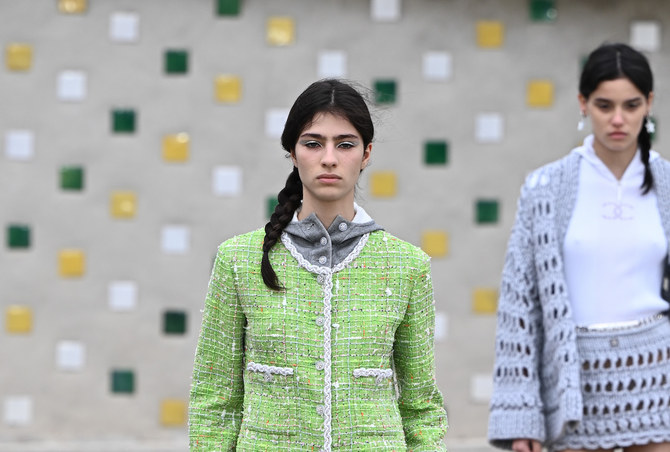
DUBAI: French Algerian model Loli Bahia, British Moroccan Nora Attal, and part-Saudi Amira Al-Zuhair took to the runway at the Chanel Cruise 2024/2025 show in Marseille, France.
Bahia donned a green ensemble, composed of a knee-length pencil skirt paired with a matching top, layered over a white shirt boasting a hoodie collar.
Attal graced the runway in a white summery dress adorned with delicate sheer geometric prints, complemented by white slippers.
Her look also featured beach-inspired layered necklaces, a thin chain belt and chunky bracelets adorned with hat, ship anchors and Chanel logo pendants.
Meanwhile, Al-Zuhair sported a vibrant yellow ensemble featuring hot shorts paired with a button-down top and a coordinating cardigan.
She also wore a beige hat, a gold choker embellished with blue detailing, chunky earrings and a chain belt adorned with pendants.
From intricate embroideries to dazzling sequined jackets and swimwear, Creative Director Virginie Viard’s latest collection showcased ensembles inspired by an underwater reverie.
The outfits included knee-length Bermuda shorts, high-waisted shorts, loose trapeze dresses, and large outerwear. Viard also demonstrated the power of layering, using shirt collars, French cuffs and jackets in unexpected ways throughout the collection.
Earlier this week, Chanel shared a series of images, captured by British photographer Jamie Hawkesworth, on Instagram featuring Bahia. The pictures, drawing inspiration from the seaside and scuba diving, provided an initial preview of Viard’s collection.
Bahia showcased multiple ensembles from the collection in the photographs. In the first shot, she dazzled in a glitzy black sequined mini pencil skirt and blazer. Another image captured her wearing the green ensemble seen on the runway, with the hoodie of the white shirt covering her head.
Additionally, she was photographed donning a white one-piece swimsuit adorned with a black bow around the chest.
The photo series also featured Bahia in a variety of other outfits, including a vibrant white dress with colorful square-like designs, tailored shorts paired with a blazer, as well as a striped set featuring a full-length skirt and matching top.
Saudi Arabia announces Red Sea Fashion Week
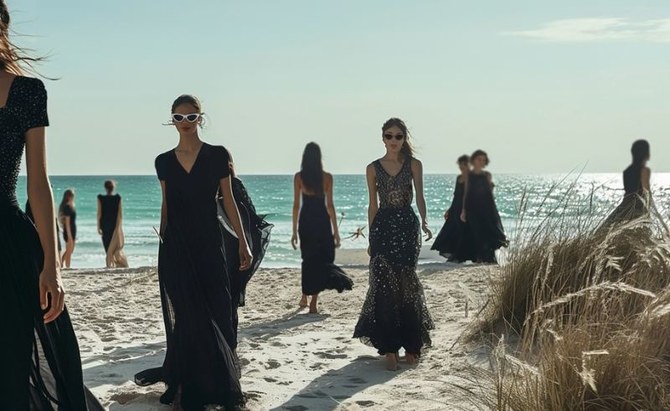
DUBAI: The Kingdom is all set to host the inaugural Red Sea Fashion Week. Set against the waters of Ummahat Island, the glitzy event is scheduled to take place from May 16-18 at The St. Regis Red Sea Resort.
Red Sea Fashion Week, which is organized by the Saudi Fashion Commission, will showcase local and international designers. It aims to celebrate the fusion of traditional Saudi aesthetics with cutting-edge contemporary design.
Among the highlights will be the participation of Saudi 100 Brands, an initiative spearheaded by the Fashion Commission to support and promote emerging local talent.
Saudi Arabia played host to its first fashion week in 2023, in Riyadh. The event took place in the King Abdullah Financial District from Oct. 20-23 and set the stage for a new fashion capital in the Middle East.
Bella Hadid launches Orebella fragrances
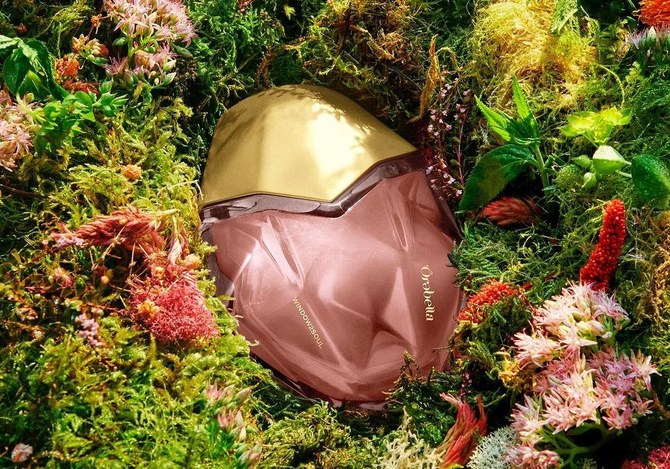
DUBAI: American fashion model Bella Hadid has launched a range of fragrances under her beauty brand, Orebella.
The entrepreneur, of Dutch and Palestinian descent, posted pictures of herself alongside the products — Salted Muse, Blooming Fire and Window2Soul — on Instagram.
The fragrances are available in 10, 50 and 100 mL bottles.
Hadid described them as “hydrating, alcohol-free and enriched with essential oils.”
According to reports, the Salted Muse fragrance has top notes of sea salt, pink pepper and carbon dioxide extract, heart notes of olive tree accord, fig and lavender, and base notes of cedarwood, sandalwood and amber.
Blooming Fire has bergamot, cedarwood, clove leaf and cardamom, followed by Tahitian monoi and jasmine and finishes with patchouli.
Window2Soul has a blend of lemon, geranium and mint in its top notes, transitions to jasmine and damask rose and ends with a base of tonka bean.
“For me, fragrance has always been at the center of my life, helping me feel in charge of who I am and my surroundings,” Hadid said on her website.
“From my home to nostalgic memories, to my own energy and connection with others, scent has been an outlet for me. It made me feel safe in my own world.
“Through my healing journey, I found that I was extremely sensitive to the alcohol in traditional perfumes, both physically and mentally, it became something that was more overwhelming than calming to me.
“That is the main reason I wanted to find an alternative, so essential oils became an artistic and experimental process for me.”
Hadid said she started growing lavender on her farm and learned about her family’s tradition of making scents.
“I realized I might have a calling in this. I found healing, joy and love within nature’s scents.
“This is why I am so proud of Orebella. It was truly a dream and a passion that through the universe and authentic dedication was able to become this brand.”
Riyadh-based soap-maker Mayssam Tamim’s compelling chemistry of Saudi fragrances and flavors
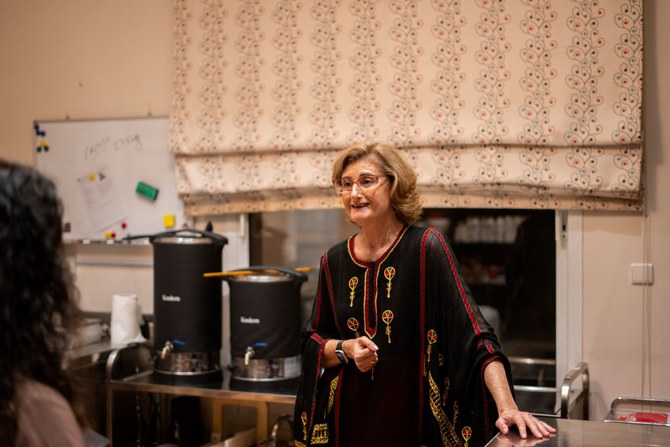
- Businesswoman uses locally-sourced ingredients, no chemicals
- Olive oil, camel milk, honey, dates, Zamzam water key materials
RIYADH: Mayssam Tamim has had a passion for handmade soaps from a young age, and as an adult would search the globe for such products.
She discovered various products in several cities including Tripoli’s eco-friendly creations at Khan Al-Saboun and Provence’s boutique lavender offerings.

In 2018, she decided to set up her own company, the Riyadh-based Mayassem, that produces luxury handmade soaps from Saudi Arabia-sourced natural ingredients.
She told Arab News: “My hope is these soaps, at least a few of the ones that become traditional, are going to help establish something in Saudi Arabia that is considered pure to the region. It doesn’t have to be just my brand of soap, but it can be an industry that is localized.
“We’re doing everything new in Saudi Arabia. Why not this?”

Her products have no harmful chemicals and are handcrafted at her home atelier using sustainable, organic ingredients to ensure that they are gentle on the skin. The materials are locally sourced including extra-virgin olive oil from Al-Jouf, camel milk from Janadriyah, honey from Baha, and dates from Qassim.
She considers the soaps mini canvases, each splashed with a unique blend of non-toxic coloring inspired by their ingredients. The “Bliss” bar for example, made with Zamzam water and lavender fragrance, is crafted to resemble the Kaaba. The “Tamr” bar reflects the palette of the Saudi Arabia landscape as it features oud, saffron and turmeric fragrance, date paste, and camel milk.
“I know it’s a soap and not a painting but sometimes it is a feeling in me. I was very sad at the loss of a cousin, Rana, which in Arabic means song. So for one of my soaps, I decided to go with blue colors and called it ‘Celestial Melody.’ Sometimes it’s just things that simple,” the artisan said.
The soaps come in floral, fruity, woody, citrus, or unscented options. While their main categories are classic, seasonal and signature, she also crafts limited-edition soaps, including an 18-box drop featuring bars encrusted with crystals such as lapis lazuli and black onyx. The brand also offers hand-poured candles made with natural soy, coconut and beeswax, as well as hand cream.
“People can buy soap 10 times cheaper at the supermarket. If I’m not offering them something that adds to the moisturization, that is organic, that does not harm them, and remains beautiful as long as they’re using it, I might as well not start at all,” she said.

With her background in biology, the chemistry of soap-making came naturally to her. She began experimenting, with aesthetics and organic products in mind, over a couple of years until she began testing her final product on family and friends.
After retiring from the UN Development Program, Mayassem began investing her time in her business. Her products have been featured in shops at Jeddah’s Islamic Arts Biennale and Diriyah’s Contemporary Arts Biennale, various homegrown market locations, and pop-up stores.
“I think I’m living the best years of my life because I’m thoroughly working on something that I’m enjoying tremendously. Not to say that I did not enjoy my career. I was very happy with the work I did, but it was time to start a new chapter in my life,” she said.
While artisans have been embedded in local culture for ages, the brand aims to call attention to their value by keeping the business hand-crafted and artisanal in line with its ethos. “I don’t want it to become a job. I want it to stay a passion,” she said. “Artisans, whether they’re making soap, embroidery, or painting, bring out the value in a country. And we have different regions, so it also brings out the identity of a country.”




